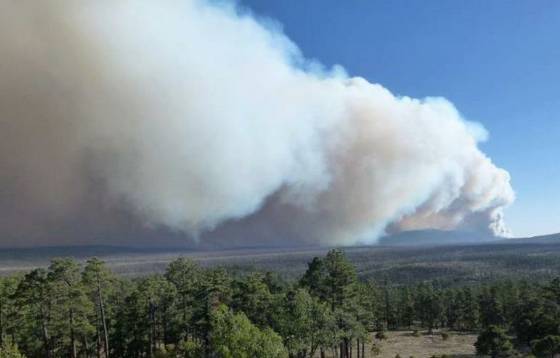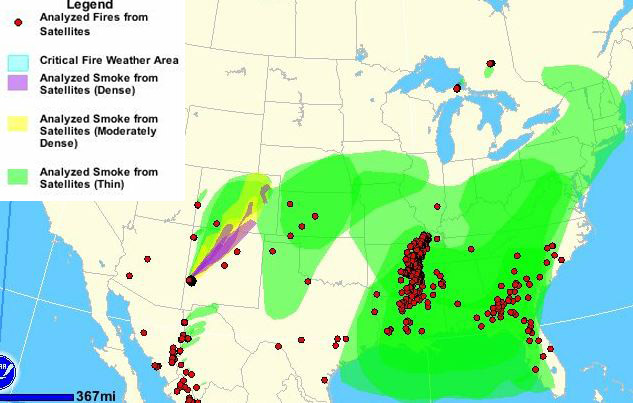
Whitewater-Baldy fire, as seen from the old Negrito fire lookout tower, 5-26-2012. NWS photo
The Whitewater-Baldy fire in western New Mexico continues to grow virtually unchecked. Before Saturday?s additional romp, it had burned 82,252 acres and there was no containment of the perimeter. (See the map of the fire below.) By Saturday evening the size was 100,000 acres, according to New Mexico State Forestry.
The Catron County Sheriff?s Office required a mandatory evacuation of the town of Mogollon. This is not an ordinary evacuation, since the population is listed at zero, but there are structures that will be endangered that are listed on the National Register of Historic Places.

Smoke map - 9:13 p.m. MDT, May 26, 2012. NOAA
For the last several days the fire has been adding tens of thousands of acres daily, while putting huge quantities of smoke into the air. At Wildfire Today, this morning we received three calls from residents of Colorado, including one from the Denver area, from people who thought they may be in danger from a nearby fire, but the smoke they were seeing and smelling was generated by the Whitewater-Baldy fire, 470 miles away from Denver.

Smoke Whitewater-Baldy fire 7:15 p.m. MDT, May 26, 2012. NOAA and Wildfire Today
A?Type 1 Incident Management Team?led by Incident Commander Tony Sciacca was ordered on May 24. They completed their transition and assumed command of the fire at 6 a.m. Saturday morning, May 26. At that time the resources assigned to the fire included 26 engines, 2 dozers, 4 helicopters, 13 hand crews, and 586 personnel.
This is fewer resources than were on the 2,500-acre Banner fire east of Julian, California on Thursday, which had in the early stages of the fire,?40 engines, 6 air tankers, 6 helicopters, and 8 hand crews. By Saturday when the Banner fire had grown to 4,100 acres but was winding down and resources were being released, CAL FIRE?s web site listed the resources assigned as follows: 73 engines, 2 dozers, 2 air tankers, 7 helicopters, 47 hand crews, and 965 personnel.
Saturday morning there were only two large air tankers in New Mexico, working out of Albuquerque. In the afternoon, Neptune?s Tanker 40, the BAe-146 jet, began its contract for this year and flew from their Missoula base to Albuquerque, presumably to work on the Whitewater-Baldy fire.
Here is an excerpt from the Incident Management Team?s Saturday morning update:
Today?s weather calls for another difficult day for firefighting. Sustained and gusting winds from the south and southwest will elevate the fire behavior beyond the critical point and crews are anticipated to face extreme conditions. Fire crews will continue in their attempt to gain control of this aggressive fire.
The greatest potential for fire growth will be generally to the north/northwest, with the fire being pushed by the high winds.
Where possible, structure protection measures are being implemented where homes and outbuildings are located.
Crews will be working to strengthen existing fire lines along the northeast section of the fire and will scout contingency lines. Additional helicopters have been ordered to support ground crews and provide structure protection if needed. Fire growth to the south and to the east is expected to moderate due to the fire entering an area of old fire burns where the fuel load is less.

Map of the Whitewater-Baldy fire, showing heat detected by satellites at 3:03 p.m., MDT May 26, 2012. The red areas are most recently burned.
The locations of the 11 large air tankers on contract this year, as of Saturday morning:
- 2 in California
- 2 in Colorado
- 1 in Arizona (there is an unconfirmed report this was later moved to California)
- 2 in New Mexico
- 3 in Nevada
- 1 in Missoula (later moved to New Mexico)
It is only May. We are barely beginning to enter the traditional western fire season, but the shortage of large air tankers is woefully apparent. There are not enough of them for initial attack on new fires, or enough after the little fires escape initial attack and become extraordinarily large. Ten years ago we had four times as many air tankers as we have today. It is obvious that 11 air tankers are totally inadequate.
Climate change is happening, and?wildfires are larger than they used to be.?Air tanker change?is also happening, but has gone in the other direction.?A logical person would expect that there would be a commensurate change in our firefighting capability. But the management of our firefighting resources, and especially our aerial firefighting resources, has not always been logical in recent years.
Meanwhile, the three Very Large Air Tankers (VLAT), the two DC-10s and the 747, sit, unused, since the U.S. Forest Service is not interested in awarding exclusive use contracts for these aircraft that can carry five to ten times more retardant than the 10 P2Vs we are currently using. If the three VLATs each made one sortie to a fire, they would carry, combined, twice as much fire retardant as the ten P2Vs combined. The VLATs are not the panacea for fire suppression, and are not the perfect aerial resource for every fire, but, there are no other large air tankers available and ready to fly right now, and they can carry a shitload of fire retardant. It is crazy for the U.S. Forest Service, especially under these climate conditions, and the fire situation we find ourselves in today, to not utilize these resources.
mass effect 3 launch trailer yelp huntsville al channel 2 news adrienne bailon yelp stock honda classic
No comments:
Post a Comment